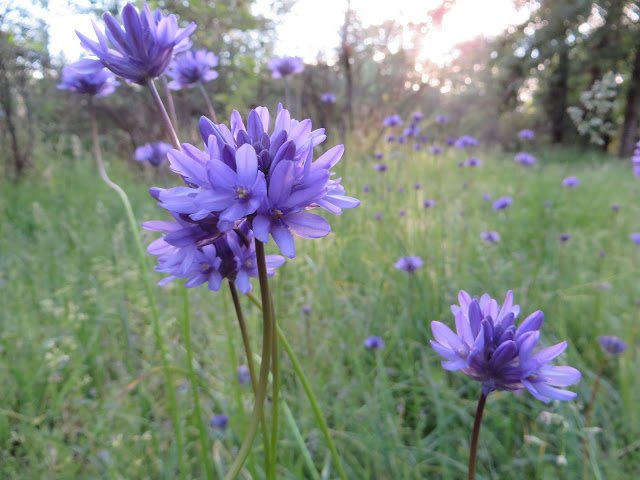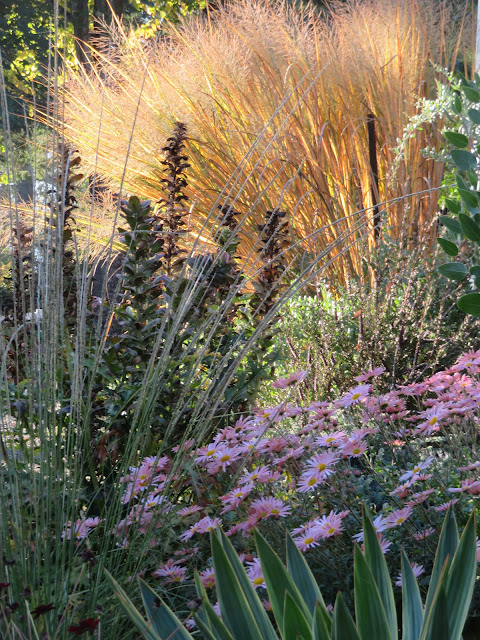Native Wildflowers of McCormick Park, Saint Helens
The local park here in Saint Helens is a sleepy surprise. McCormick Park is several acres of mixed-use recreation and trails with areas of oak woodland, open fields, Milton Creek and coniferous forests. Periodically, FM and I enjoy a two or so mile loop-walk through these areas to get away from the farm for a brief time. There are a surprising number of native wildflowers, trees, shrubs and grasses, and I have enjoyed observing them. Just recently we went for a walk and noticed many wildflowers in bloom; I thought they are worth sharing. Here are simply a few of many we observed.
First up is Dichelostemma congestum or ookow. This was actually taken last May and is not in bloom right now but it's one that is so pretty I had to share it. These grew in open meadow areas with lots of sun.
Saint Helens has a garden club, who knew? I'll have to look into that. Also, a touching memorial to veterans from several wars.
Erythronium oreganum, commonly known as either trout lily or white fawn lily. It is found in moist woodlands west of the Cascade Mountains and dotted this park in woodland areas as well as open wet fields. Amazing little gem of a wildflower.
Here it is again photographed in an open field.
Our native bleeding heart, Dicentra formosa. We observed this both sprinkled here and there and massed like this in woodland areas. This sweet little plant seeds around and adds a ferny texture to an otherwise sea of plain green leaves. It looks good most of the season, too. I have a white version of it in my own woodland garden.
False Solomon's seal or false lily of the valley, Maianthemum racemosum, grows in large colonies throughout the woodlands of the park. A very useful plant at that magic height of 2' -3' with interesting stems and leaves. It also produces berries for wildlife.
The leaves do resemble Solomon's seal, it can all be quite confusing, but these have terminal flowers where Solomon's seal has bell-shaped flowers dangling along the stem from below.
To make matters even more confusing, this is also Maianthemum but Maianthemum stellatum, starry false Solomon's seal. This is also a creeping perennial in wet woodlands and meadows. Both are quite common but so lovely.
One of my favorite violets, Viola glabella or streambank violet is abundant this year because, well, it's been so wet. I'm hoping to establish this in my own woodland area to help take over the invasive plants. A carpet of this is so cheerful:
Isn't it lovely? It looks great all season with adequate water and is a food source of fritillary butterfly larvae. It's also a wonderful little plant for pollinators.
This was new to me, Lithophragma parviflorum or prairie star. Grows in grasslands and dry open areas, I would love to grow some in my wilder areas. It's common on the West Coast, says my wildflower book, but I cannot recall ever seeing it.
Here's a two-for-one. Trillium ovatum and Vancoveria hexandra or inside-out flower. The trillium is a familiar early spring flower to many in the Pacific Northwest. While usually white, occasionally you see a pink version. The Vancoveria hexandra is a deciduous spreading ground-cover that sends up spikes of little white flowers that really do look as if they've been turned inside-out. I love this plant, it's so airy and light and doesn't take over. I kind of wish it would, but for me it's been slow to spread.
I believe this is some kind of Lomatium or biscuit root, desert parsley, or wild parsley. We did not see much of it, but this little patch stood out in the middle of a grassy field.
Just a nice rock. That is all. FM is unwilling to carry it to the pickup and cart it home. Enough with lifting and groaning, he cries out! Some of those marks on the stone might be from disk-golf disk strikes. There is a full 18-hole? course in McCormick Park. We always see throwers winging their disks around.
The oak trees of this park generally border open meadow areas. Saint Helens has a base of basalt rock, so when it rains there are many vernal streams and pools that support this type of landscape and you will often find Camassia quamash or common camas growing in these wet fields that dry out in the summer.
This photo is from last year, although the camas blooms were everywhere in the park. Just not quite open yet, about three weeks later than last year. I blame the weather. We are positive better weather begins at 5 pm later today!
More open oak forest area with many camas bulbs in there as well as lilies, trilliums and ookow all waiting for some sunshine to put on a wildflower show.
This giant trillium was spotted in the middle of that field - Trillium chloropetalum.
The water was a little high in Milton Creek. We've had just a bit of rain. This was taken a few weeks ago, it looks nearly the same today.
Again, lots of water. Maybe the abundance of wildflowers is a result of this.
This was taken at the same time of the water photo with Facilities Manager and his mom, Sharon, who was visiting from Idaho. She loved all of the wildflowers and happily stopped with me to observe and take photographs. Thank you, flower-lover Sharon!
FM says, yes, his mother is a hobbit.
Tellima grandiflora or fringecup foliage carpeted many parts of the woodland floor. I have this, too. In fact, it was probably here all along. It's my ally in covering the woodland ground quickly as I weed out the invasive plants. If there's bare earth, I'd rather have this seeding in my garden than English ivy or blackberry.
Not the best photograph in the world, but I admit I only had my phone with me this latest visit to McCormick park, not my camera. Mahonia aquifolium (or nervosa), or Oregon grape. These evergreen shrubs are also the state flower of Oregon and provide great cover for birds and food in the form of steely-blue berries later on. I have many of the lower M. nervosa in my woodland garden that were also probably always there. Last year they were freed from the blackberry and other smothering plants and have since put on a considerable amount of growth. I'm happy to see they are all blooming, too, which is something that did not happen last year.
Happy trails, Facilities Manager! Thank you for the break in farm work. I'll always go for a walk in the woods with you! FM says ditto, CG (Chickadee Gardens).
Also seen but not photographed on this recent walk due to low light levels was snowberry or Symphoricarpos albus, Hooker's fairy bells or Disporum hookeri, salmonberry or Rubus spectabilis, Pacific ninebark or Physocarpus capitatus, many ferns and trees, too.
I so enjoy seeing these special woodland plants in their native habitat thriving and untouched. I was in paradise. I would never collect these plants in the wild. I leave them for others to enjoy and to be able to grow without interference from me. Besides, they would likely not survive if I did take them. Seed, on the other hand, I would gladly collect to see if I could get it to germinate.
That's it for this week at Chickadee Gardens. Thank you for reading and until next time, happy gardening!
Also seen but not photographed on this recent walk due to low light levels was snowberry or Symphoricarpos albus, Hooker's fairy bells or Disporum hookeri, salmonberry or Rubus spectabilis, Pacific ninebark or Physocarpus capitatus, many ferns and trees, too.
I so enjoy seeing these special woodland plants in their native habitat thriving and untouched. I was in paradise. I would never collect these plants in the wild. I leave them for others to enjoy and to be able to grow without interference from me. Besides, they would likely not survive if I did take them. Seed, on the other hand, I would gladly collect to see if I could get it to germinate.
That's it for this week at Chickadee Gardens. Thank you for reading and until next time, happy gardening!



























.JPG)


.JPG)



Great shots of the wildflowers! Looks like a nice park to take a walk. I have Trillium ovatum growing in my shade garden. The flowers open white and age to that pink color. I had Tellima in my garden the first couple of years, but it was a very aggressive seeder. I don't have as much room as you, so I now pull most of them out. That's a sweet photo of FM with his mom. I sure hope things dry out soon.
ReplyDeleteThank you Alison! It is a lovely walk. Trilliums are special, I think. Glad you have some in your garden.
DeleteWow. Fabulous. I'm impressed that you can name all these. I can't even think of names for half the plants in my own garden. Maybe time to slow down and go for a walk in the woods. Inspiring.
ReplyDeleteI can name them with the help of the interwebs, dear Patricia...hee hee...ok, I know some of them but a few I admittedly had to look up.
DeleteAlways time to go for a walk in the woods. It's dragging ourselves away from the garden that's hard!
Even prettier than seeing them on your phone. Next step: get out there in person. Thanks for bringing this to our attention.
ReplyDeleteNeat! Thanks, Rickii. I hope you two have a chance to get out there!
DeleteOh, what a bounty rain brings to your wildflower areas!
ReplyDeleteOK, April showers - check.
DeleteMay flowers - bring it on!
In all the time I worked in Saint Helens...I never visited McCormick park. So nice to view it through your lens!
ReplyDelete